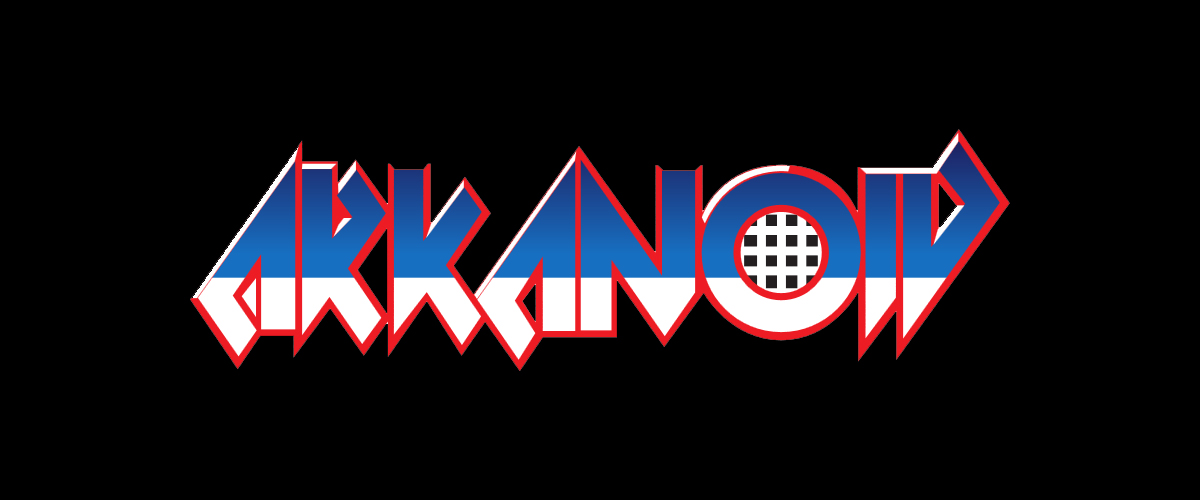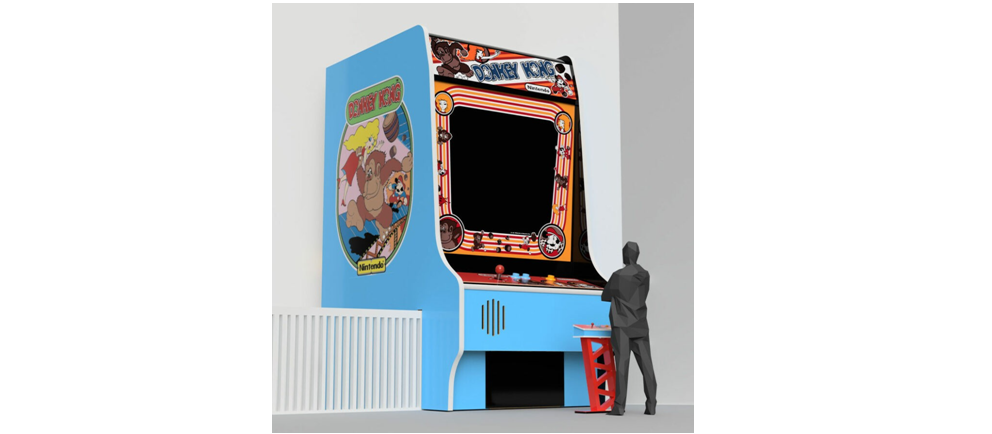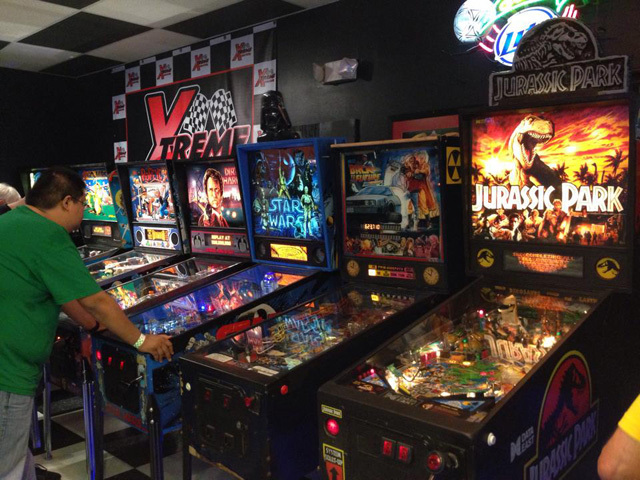Arkanoid is an arcade video game developed and released by Taito in 1986. The game is based on the popular 1976 arcade release created by Atari called Breakout and it consists of bouncing ball between a player-controlled platform on the bottom of the screen and a stacks of blocks. As the ball bounces on the block, they begin to break, granting the player points based on the color of said blocks. The objective is to break every single block on each level in order to advance to the next.
Arkanoid featured amazing colorful graphics and introduced several new elements to the “ball n’ paddle” game formula which were popular at the time. Specifically, the most important feature which provided an element of strategy were the powerups which were dropped from certain bricks upon being destroyed, and grant benefits to the player if he catches them with their paddle.
Due to the game’s popularity when it first came out, 4 versions of it were eventually released: Arkanoid, Tournament Arkanoid, and Revenge of Doh (Arkanoid II), all of which were released between 1986 and 1987, and Arkanoid Returns which was released in 1997.
This week on Getting Good, we’ll be addressing the basics of Arkanoid and will be providing several tips to maximize your score and set the new high record at the local arcade.
The Basics
Arkanoid is played entirely by controlling the paddle at the bottom (called ‘Vaus’). The player can move it right or left by rotating the control disc either clockwise or counterclockwise in the arcade version. The control scheme also features fire buttons which allow the Vaus to perform certain actions when the appropriate power ups have been unlocked. For instance, if the laser upgrade has been acquired, the fire buttons will be used to fire said projectiles. On the other hand, if the catch upgrade is acquired, the fire button will be used to release the ball.
The direction the ball will take after bouncing on the Vaus is determined by the exact place where it struck it; if it bounces off the edges of the ship, the ball will go careening towards the bricks at a very shallow angle. Meanwhile, if the ball bounces off the very center of the Vaus, it will go at a sharp angle. The red bands on each side of the ships make the ball bounce off at a 45° angle. Knowing which place the ball will bounce off to is very important for keeping it in play, correctly direct it towards the bricks, and maximizing your score.
The Bricks
As the game progresses, the player is presented with different types of bricks, all of which grant the player different amount of points, depending on their color. In the same manner, the bricks which give the most amount of points will also take more hits to break, so keep this in mind when you’re aiming to quickly clear a stage, as breaking the fragile bricks may be a better strategy over attacking the hardy bricks first.
When it comes to types of bricks, they are grouped mainly in 3 categories:
-
- Color Bricks: The most common type in the whole game, taking only one hit to destroy and granting a different amount of points according to their color. The color bricks are arranged, according to the amount of points the give, in the following manner:

- Silver Bricks: These take more than 1 hit to destroy. At the moment of their first appearance, they take only 2 hits, but the amount required to destroy them increases by 1 every 8 levels. Silver bricks also grant a ton of points: 50 times the stage number. Silver bricks on stage 32 (the one prior to the boss stage) grant the player a whopping 1,600 points each.
- Golden Bricks: These are meant to be obstacles as they cannot be destroyed by any means. Furthermore, they don’t count towards the bricks the player needs to destroy to progress towards the next stage.
The Powerups
When the player breaks bricks, there’s a chance that a powerup (in the form a capsule with a letter on it) will drop. The effect of said powerup is determined by its color and letter, and can grant the player one of the following:
- Red L: Transforms the Vaus into laser mode, which allows the player to fire projectiles using the laser buttons. Said lasers can be used to destroy bricks, even the silver ones.
- Blue E: Simply put, this powerup extends the width of the Vaus.
- Green C: Grants the Vaus the ability to catch balls. Instead of bouncing off its hull, the ball will stick to the ship, and can be released by pressing the fire button, or automatically after a certain amount of time has passed.
- Orange S: Decreases the speed at which the ball moves across the field. Although multiple instances of this powerup can stack, the ball will progressively regain its speed as it bounces back and forth between the ship and the bricks.
- Violet B: Upon collecting this capsule, a “break out” exit will be created on the right side of the stage. If the player manages to aim the ball towards this new portal, he will receive 10,000 bonus points and automatically progress towards the next stage.
- Cyan D: Upon collecting the powerup, the ball currently in play will divide into 3 instances of itself, all of which may be kept in play simultaneously if the player is skilled enough. The current life will not expire until all 3 balls are lost under the Vaus.
- Silver P: Grants the player an extra life upon receiving the powerup.
The Strategy
Arkanoid is, by far, one the most demanding games of the later 80’s in terms of player skill. Other classics like Pac-Man and Donkey Kong were definitely challenging in their own right, but the difficulty of these games is reduced considerably when you know what to expect and which movement patterns are the optimal for clearing each stage. Arkanoid, on the other hand, plays differently each time and depends solely on player skill in order to adapt and complete the game in a timely manner.
In this sense, the best way to improve your skill at Arkanoid is by simply playing the game, growing familiar with how the ball works, and keeping at it until you feel comfortable enough with the controls and are able to easily aim the ball towards the openings at all times.
That being said a good strategy to adopt is focusing on one block at a time so you can create an opening towards the top of the stage. Once the ball is above the bricks, it’ll likely bounce back and forth between the roof and the brick wall, destroying everything in its path. Be careful with this strategy, though, as the ball will likely gather much momentum in its path of destruction and you’ll have to anticipate it as it comes back down towards the Vaus. Before attempting this, it pays to have an Enlarge powerup, as it will allow you to better catch the ball once it finally comes back down.
Arkanoid is one of those games that requires constant practice in order to master, unlike others where knowledge of the mechanics are paramount to excelling at them. Arkanoid is all about adapting to the situation and developing the skills required to aim the ball properly. If you can get that down, then odds are that you’ll do great at the game.
That being said, here at PrimeTime amusements we’re always at the forefront when it comes to arcade game sales and rentals. If you’re looking for a machine in particular for your game room, or simply need guidance to get started, feel free to contact us at 1.800.550.0090, or pay us a visit at 5300 Powerline Rd, Suite 210, Ft. Lauderdale, Florida, 33309






I really like the blog on Arkanoid: Getting Good. Very informational. For the skilled player who can make it to the end (stage 33 – the boss DOH), the only thing left to do in the game is to find strategies to elevate your score because it has an inevitable end. Here are a couple I can share.
Collecting capsules: Capsules award 1,000 points, but only “1” can be on a screen at a time. So the way to points-press capsules, is simple. Hit a brick to release a capsule. As soon as one drops, try to divert the ball to an area where there aren’t any bricks, to buy some time until you’re able to collect the capsule as it falls. If you repeat this throughout the stage, you will be able to reap some decent points by the end of a given stage. If you don’t have an area to divert the ball away from any bricks, then hit the ball on either edge of the paddle, thus sending it towards the top in a more horizontal ricochete. This will also help buy time until you’re able to collect the falling capsule, before the ball hits a brick to release the next one. You may hit a 2nd or even 3rd brick while the ball is still on the screen, but that’s ok. By the end of the stage, you’ll notice a big difference in the amount of points you were able to get from doing this strategy. Repeat this on each stage as you progress through the game.
“B” Capsule (Purple): Whenever one falls and is collected, do your best to avoid going through the break until their are a minimal number of bricks left on the stage. Obviously, the closer to completing the stage, the more challenging it gets. Don’t cut it too close, otherwise if you accidentally clear the stage of bricks and advance to the next stage without going through the break, you will lose 10k for not using it. Sometimes things get really hectic and really fast and you just come too close to the break and end up getting sucked through it. That’s ok. Better to have this happen, than fall short of the ball and die. Then you’ll lose a paddle AND the opportunity to go through the break and collect 10k.
“D” Capsule (Cyan): Whenever this one is collected, immediately let 2 of the 3 balls drain. Otherwise, no more bricks will come out while there are more than 1 ball in play. Collect it, for the 1k, but then let 2 of the balls drain on purpose.
“L” Capsule (Red): This weapon is your best friend throughout the game. It’s this weapon, that will allow you to get the most amount of points on each of the 32 stages, than any other one capsule. Yes, even the 10k break capsule. Basically, once collected, destroy a path of bricks to the top of the screen, to allow the floating “orbs” as I call them, to make their way down towards the bottom of the screen. Your objective is to shoot as many of these orbs as you possibly can, as the ball is slowly (or fastly if it’s gotten to the level) destroying bricks. The biggest challenge, is being able to shoot the orbs, by diverting the ball either away from any bricks (to keep you on the stage as long as possible) or by sending the ball ricocheting from side to side in a horizontal manner (off of the edge of either side of the paddle), thus taking the ball longer to get to the top of the screen where it will eventually take out one or more bricks. Some stages don’t allow the orbs to come out, if this is the case, just shoot one brick at a time, slowly, until the next capsule drops. Than stop shooting bricks until you collect the falling capsule. It won’t matter if you lose the laser, there isn’t any orbs to shoot at for points anyway so you’re good in just collecting capsules for the remainder of the stage in order to maximize your points on said stage.
“P” Capsule (Gray): The frequency at which the game drops this capsule on any given stage, is completely random. You want to do your best to grab this one, every chance you get, obviously without putting yourself in jeopardy of missing the ball if you can’t get over to the capsule in time. Each paddle you bring into stage 33 (the boss) is 15k (I’ll explain this next), so if you can grab one, do it! It’s worth big points on stage 33.
Stage 33 – “DOH – The Boss”: This character, which clearly resembles Moai, a stone statue that was carved by the Rapa Nui people on Easter Island in eastern Polynesia (for a little history), is who will award you a HUGE amount of points if played right. First, prior to reaching this stage, you want to do your best to conserve as many of your paddles as you can. Translation, reach stage 33 with as minimal amount of deaths as possible. A player having a really good game is when their game is very generous and drops “P” capsules pretty frequently throughout the game and the player is also able to points-press dramatically, to where his score going into stage 33 is somewhere between 950k and 1M points. So the objective on stage 33 is to hit DOH 16 times with the ball, while avoiding the floating diamonds that come out of its mouth as they drift down toward the bottom of the screen. You must avoid them, as well as being able to keep the ball in play long enough to hit DOH 16 times in order to defeat him and win the game. But, you “DO NOT WANT TO DO THIS ON YOUR 1ST PADDLE!!!!” Otherwise, you will end the game and ALL of your accumulated paddles go by-by, and you get “0” points for all of them. So here’s the strategy for reaping big points. You want to strategically, and you will find that “sweet spot” where when you release the ball, it will bounce off the wall and over the top of DOH’s head either 2 or 3 times, before bouncing over to the other side, for you to repeat this process, thus sending the ball back over to the opposite side, after the ball bounces off his head again, either 2 of 3 times. You MUST keep a count of how many times you hit him. If you lose count, die on purpose as soon as possible, before DOH turns purple (one shot away from defeating him). If you can focus long enough (“cashing in” all your paddles can take upwards of 30 minutes in itself, depending on how many you’ve accumulated throughout the game) and can maintain a rhythm where you’re able to hit DOH 15 times and then die immediately by either moving the paddle to the opposite side of the falling ball or run into one of the floating diamonds, your score will grow exponentially! Understand that each hit to DOH, awards you 1k. So hitting him 15 times and then dying while he’s purple, awards you 15k for “cashing in” that paddle. If the game is set to default settings, than it’s set to award the player an extra paddle every 60k. So do the math. Every 4 paddles you expend, you will gain a new one and another shot at another 15k points!!
How do I know so much about this game? Well, I currently hold the #2 highest score in the world on this game since 1999, as per Twin Galaxies. I held the previous world record for about 13 years, before beating my own record back in 1998. My final score was 1,466,460 points. I held onto the title, for about a year, before another player by the name of Zack Hample, who inevitably became one of my best friends, decimated my score in front of me on his very 1st token at the Funspot arcade in Weirs Beach, NH during a tournament we attended. He played for almost 2 straight hours on 1 token and scored 1,658,110 points! His record still stands to this day.
Note: TG currently shows me in 3rd place with a lower score. However, sometime when TG was under new ownership, it was during this transition that my record somehow was replaced by my previous record which was a much lower score for whatever reason.
Hope you enjoyed my “advanced” strategy guide and it helps you to improve your own scores!
Stephen Krogman
Arkanoid – 1,466,640